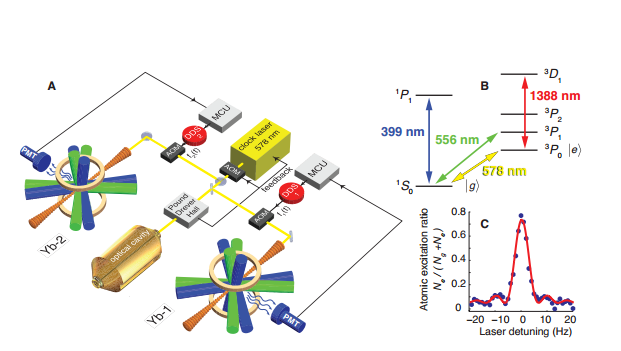Physicists Unveil World’s Most Precise Clock (And a Twin to Compare It Against)
Clocks are one of the enabling technologies of the modern world. Without highly accurate clocks, the global positioning system would not function correctly, neither would it be possible to synchronise networks over vast distances. And physicists rely on clocks to test the fundamental laws of the universe to ever deeper levels.

So having more accurate and reliable clocks is an important goal.
Today, Andrew Ludlow at the National Institute of Standards and Technology in Boulder and a few buddies unveil the two most accurate clocks ever built. They say their new clocks can keep time with an unprecedented precision of one part in 10-18.
Ludlow and co put this in perspective: “A measurement at the 1018 fractional level is equivalent to specifying the age of the known universe to a precision of less than one second or Earth’s diameter to less than the width of an atom.”
Their clock is a simple beast, at least in principle. The basic idea is that a second can be defined by the frequency of light emitted by an atom when electrons in the ground state jump to another state.
The difficulty is measuring this frequency accurately. That’s because any small movement of the atom generates a Doppler effect that shifts the frequency. What’s more, stray electric fields can shift these electronic transitions, changing their frequency, a phenomenon known as a Stark shift. Overcoming these small sources of error is the major challenge in building accurate clocks.
Ludlow and pals have done it using a technology known as an optical lattice clock. In this approach, they bounce a laser off a mirror to create a standing wave of light which forms a lattice to trap atoms. This is a kind of eggbox in which the atoms sit.
They then fill this eggbox with ytterbium atoms and zap them with another laser to see the frequency at which the electronic transition occurs.
The eggbox is important because it holds the atoms in a vice-like grip that minimises any Doppler effects.
However, electric fields associated with the light generate a Stark shift. The team get around this by choosing a so-called “magic” transition in ytterbium in which both electronic states are shifted by the same amount, leaving the transition frequency unchanged.
And because the eggbox can be filled with many atoms, Ludlow and co-can make their measurements using many atoms so that get a clearer signal.
The result is a clock that loses only one “tick” in 1018 “tocks”.
Of course, there’s no way to measure the accuracy of a single clock, which is why these guys have two.
The new clocks immediately make possible a number of new and important applications. These clocks are so sensitive that they can easily measure the gravitational redshift, in which clocks tick more slowly in more powerful gravitational fields. In other words they can sense changes in height.
The best clocks today are sensitive to changes of many metres or kilometres. The new clock should be able to discern changes of around 1 cm at the Earth’s surface. That will be for applications such as hydrology, geology and the measurement of ice pack changes in climate change studies.
It would also physicists to test whether things like gravitational red shift and the fine structure constant change with position, important fundamental tests of physics.
The improvement of clocks is an ongoing process that humanity has undertaken over several thousand years. These latest timepieces are the impressive culmination of all this work and yet they are bound to be eclipsed in the not too distant future.
Indeed Ludlow and co point to various improvements that they had to make in the near future to make their clock even better. And when they do the next clocks will be even better. Such is the nature of technology.
Ref: http://arxiv.org/abs/1305.5869 : An Atomic Clock With 10-18 Instability
Keep Reading
Most Popular
Large language models can do jaw-dropping things. But nobody knows exactly why.
And that's a problem. Figuring it out is one of the biggest scientific puzzles of our time and a crucial step towards controlling more powerful future models.
The problem with plug-in hybrids? Their drivers.
Plug-in hybrids are often sold as a transition to EVs, but new data from Europe shows we’re still underestimating the emissions they produce.
Google DeepMind’s new generative model makes Super Mario–like games from scratch
Genie learns how to control games by watching hours and hours of video. It could help train next-gen robots too.
How scientists traced a mysterious covid case back to six toilets
When wastewater surveillance turns into a hunt for a single infected individual, the ethics get tricky.
Stay connected
Get the latest updates from
MIT Technology Review
Discover special offers, top stories, upcoming events, and more.